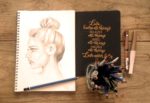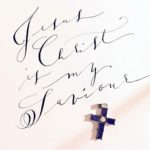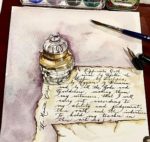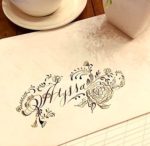MERE mortals of this earth have the propensity to love beautiful things. A selected few—those gifted with demigod powers—create beauty, a surefire talent that elevates them to climb the steps up Mount Olympus where the gods that be live to oversee the world in which we live.
Calligraphy, loosely defined as the art of beautiful handwriting characterized by swirls and flourishes, is a coveted innate talent
in which only a selected few have been blessed to possess.
We round up three women—a hospitality professional, a human resource practitioner, and a medical doctor—to share their love for calligraphy and how they work on improving their skills.
Rochelle Tabino
Working for the hospitality industry—hotels in particular—has given Rochelle the ability to interact with people. But in calligraphy,
the mother of two children, goes back to her core and communicates with her inner self to create art.
“Handwritten what-nots are personal. I taught myself the basics of calligraphy since I don’t have any formal education or training
in the art,” she says.
Rochelle gladly picked up books, browsed websites then later joined workshops to be
better in this craft.
She believes calligraphy is an art form that needs to be mastered. “Sure we all write, but there are strokes and flicks of a pen that is not easy to achieve especially without practice,” says Rochelle.
Julie Ann Oreiro
Back in high school, Julie’s classmates would often borrow her notes as her handwriting is clean and legible.
The 30-year-old psychology graduate of the University of the Philippines Cebu started her calligraphy journey as a form of stress reliever from a stressful job. Before calligraphy, she ventured into rubber stumps and paper cutting.
“By accident, I was able to browse through Manila-based people who were doing calligraphy,” she says.
This happened two years ago when calligraphy workshops and materials were very limited in Cebu. When the opportunity to attend a workshop organized by a fellow UP Cebu graduate, Julie did not have to think about grabbing the chance to learn about the art.
As luck would have it, the “teacher” was also left handed like her so Julie embraced the art like second nature and have done a couple of masterpieces used in a wedding and personal spaces of clients and friends.
Nanette Catigbe
Nanette loves the art even when she pursued a career in science as a medical doctor. In college, she started brush calligraphy on her notebook covers and journals.
“I just thought that I had a rad handwriting and it looked good with all the fancy colors,”she says.
Two summers ago, pointed pen calligraphy sprouted on social media so Nanette and husband/ fellow doctor Kiko joined the bandwagon.
“It was mainly for his penmanship to be more legible to the patients and pharmacists. We call it ECG (electrocardiogram) handwriting. We would practice daily and in between consults,” she recalls.
Nanette said she loves theelegance, the swirls and flourishes, and the sincere effort behindevery word in drawing letters via copperplate calligraphy. “It is like connecting yourself to the Masters of handwriting even when you are just starting out,” she says.
These days, Nanette is teaching people how to write more beautifully. She is holding a calligraphy class on June 2 at the PhiloSophia Library Café in Mandaue City.
“I love teaching art. I always encourage my creatives to practice at least 15 minutes a day, do warm up drills and just enjoy,” notes Nanette.
These three ladies note one important ingredient in being good at calligraphy: practice.
Because good old constant practice makes perfect art pieces.As Nanette emphasized: “There is no shortcut to good calligraphy since it is muscle memory. Fine more skills are honed until beautiful calligraphy becomes second nature. Practice daily, love it with all your heart, then reap the rewards.”
More Photos here:








